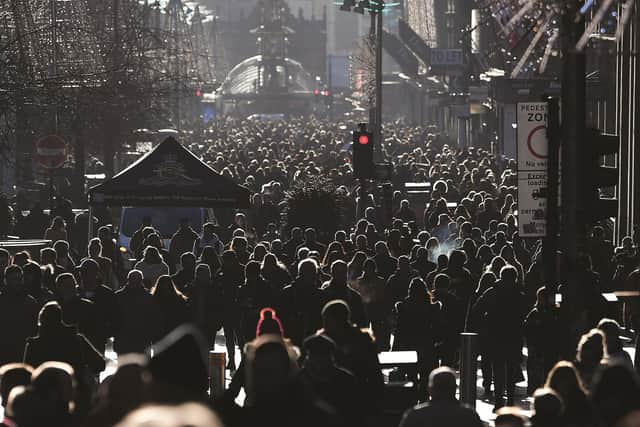Challenges for high street retailers in an age of Covid


Black Friday is a fortnight tomorrow, on 27 November. Quite what the usual pre-Christmas spending frenzy will look like after a tumultuous 2020 is hard to predict, but it will certainly be different – jostling through the door after queuing all night for a festive bargain will not be a feature of these socially-distanced times.
One certainty is that if there is a frenzy, much of it will be online. Internet sales as a percentage of total UK retail sales peaked at 32.8 per cent in May 2020, according to the Office of National Statistics, soaring from 19 per cent in February as the pandemic saw us do far more shopping online.
Although that had dipped to 26.6 per cent by August, the overall trend is only heading one way. The Only Way Is Up, as Yazz and the Plastic Population sang in 1988, a number one single which many shoppers of a certain age might have bought with cash from a high street record shop before the internet as we know it existed.


Those shoppers might have also thought back to Saturday afternoon shopping, armed with a wad of hard-earned cash, or maybe a chequebook, to buy a floral dress from Laura Ashley or new trousers from Debenhams. These are just two of the big names which have floundered in 2020 as the decline of the high street was accelerated by the coronavirus lockdown and migration of shoppers online.
As David Lonsdale, director of the Scottish Retail Consortium, has pointed out, shops faced a Covid-19 double whammy, with a challenging sales environment accompanied by higher costs.
He comments: “Retailers have worked incredibly hard and responsibly to keep customers and staff safe throughout the pandemic, investing tens of millions of pounds on safety measures including plexiglass screens, social distancing [signage] and hygiene.”
So what might post-Covid shopping streets look like as our spending habits change and famous names struggle for survival? Many well-known brands have gone into administration in 2020, including Edinburgh Woollen Mill, Cath Kidston, Monsoon, Oasis, Go Outdoors, Warehouse, M&Co (formerly Mackays), Harveys Furniture and Victoria’s Secret.


While some have re-emerged, being bought out of administration, usually with fewer outlets or online-only, the long-term trend is clear, as the economic carnage wrought by the pandemic continues to claim victims.
“I think we will see a lot of units closing, especially independent shops in the high street,” says Philip Knight, a partner with legal firm Womble Bond Dickinson and head of its real estate litigation practice in Scotland.
“Some larger shopping centres are empty and really struggling too. People do not necessarily have brand loyalty to the bigger retailers and shopping centres any more. In the longer-term, I think shopping centres will have to follow a more American model and devote more space to entertainment, restaurants and theme-park rides than to traditional retail.”
However, he adds: “Landlords of large shopping centres are going to have to be far more creative to get footfall or they will lose tenants. But it’s a double-edged sword because they don’t all have money to invest now.”
Knight says the future of town centre shopping areas will require creative responses from BIDs (Business Improvement Districts), local authorities and business forums to try to drive footfall.
He says: “Success will depend on customer loyalty and the demographic of certain areas. Independent shops will do well if they have a strong business plan and quality products in areas where people with disposable income want to shop locally.”
It’s all about location, location, location, he says: “In Edinburgh, you can see areas like Easter Road, Portobello and Leith Walk where you have clusters of great bakeries and other independent shops which benefit from people shopping locally, with lots of professionals with money to spend in the area.
“They might spend £4 on a lovely loaf of bread from 12 Triangles [which has five community outlets] rather than pay £2 at a supermarket.
“If you have the right kind of ‘fit’ with your local community, people will spend money there.”
This “fit” might also deliver benefits for businesses who supported their local communities with home deliveries during the early stages of lockdown, while those with strong online channels should also thrive, says Knight.
Yet he also recognises that many smaller retailers could struggle because the macro-economics of the pandemic aren’t necessarily in their favour.
“Some larger retailers are managing to negotiate great deals – big discounts on rents or and even rent-free in some cases,” says Knight. “They can do this because they have advisers, extensive market knowledge and deep pockets.
“In the longer-term, they will look at stores that are not performing and either ask to go rent-free or threaten to terminate their lease. They will concentrate on the core of shops that make money. Before the pandemic, a landlord might have just kicked out a retailer if they asked for a big rent reduction because they knew they could get another retailer in. That’s not so easy now.
“Smaller retailers could be at a real disadvantage because they might not know the range of options at their disposal and don’t have the capacity or advisory support that larger retailers do.”
So how many retailers on our high streets for Black Friday 2020 will have a good enough Christmas to last into 2021 and be here for Black Friday next year?
There is some hope, with consumer spending already starting to pick up and the prospect of far more spread-out Christmas spending, both to avoid excessive costs in a single month and to stay away from shops at their busiest.
When encouraging retail statistics emerged in September, Helen Dickinson, chief executive of the British Retail Consortium, said: “With office workers still at home for the foreseeable future, sales of electronics, household goods and home office products remain high.
“September sales have also given retailers early signs that consumers are starting their Christmas shopping earlier this year, which retailers are encouraging their customers to do in order to manage demand at Christmas and keep people safe.”
Commenting on the same figures, Paul Martin, UK head of retail at KPMG, said: “The resilience of British retailers has been nothing shy of remarkable in recent months, with 6.1 per cent like-for-like growth in September serving to reinforce that. That said, this month’s uptick is against the woeful performance recorded in September 2019 and so caution remains vital.
“Online sales have eased slightly, but it’s clear the convenience of the channel is so well ingrained into the consumer’s psyche now and is therefore here to stay.”
So how much of our traditional Christmas splurge will be online? Rather like the rest of 2020, it’s hard to say, especially as rising unemployment and pressure on family budgets could depress spending generally, while further lockdowns could see non-essential retail closed down again.
Industry experts think online sales will be 30 per cent higher than last year for the peak festive trading season, and if stores have to close, this could hit 50 per cent.
All retailers are having to adjust, including big high street names like Boots. Its chief executive Seb James says: “Festive shopping will be much more online, so we’ve tripled our online capacity. Secondly, people are going to be much more anxious about money so value is going to be much more important this Christmas.”
Discover more at www.womblebonddickinson.com/uk